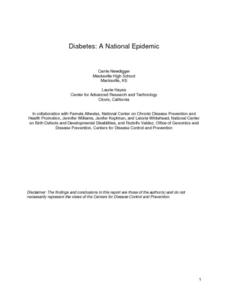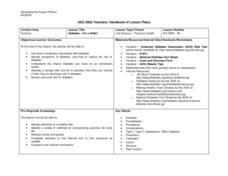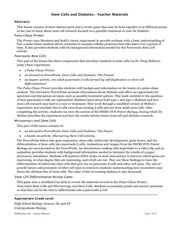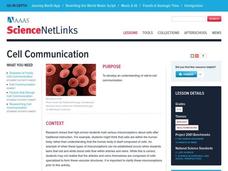Howard Hughes Medical Institute
Classroom Activities: Stem Cells and Diabetes
A multi-faceted lesson immerses AP biologists into the world of the stem cell. Using PowerPoint presentations, you introduce your class to diabetes and the possibility of finding cures through stem cell research. Online animations and...
Curated OER
Bisphenol A and Diabetes
Pupils summarize the data that is displayed and examine how bisphenol A behaves and how it contributes to diabetes. Learners also study an article and interpret line graphs.
Curated OER
Why Can’t I Have Sugar? All About Diabetes
Begin the instructional activity by having your class write what they know about diabetes. They learn through a skit how the body metabolizes glucose. A visual representation of the two types of diabetes is displayed, and then learners...
Nemours KidsHealth
Diabetes: Grades 3-5
Students investigate personal health by researching healthy eating on the Internet. In this childhood disease lesson, students discuss diabetes, the causes, and ways it can be prevented. Students complete worksheets based on potentially...
Curated OER
What is Diabetes?
Students examine basic information about diabetes and related vocabulary words. They explore various health websites, complete a worksheet, discuss the worksheet answers and discuss diabetes myths vs. facts.
Curated OER
Diabetes: A National Epidemic
Students investigate the disease of diabetes. They observe research results to graph the trends of diabetes to contribute to the problem of being overweight. They explain in class discussion the physiological changes that occur in the...
National Nanotechnology Infrastructure Network
The Blood Glucose Monitor
Become a doctor for a day! Learners analyze synthetic urine and blood samples to diagnose diabetes. They use lab procedures to identify abnormal glucose levels, and, as a follow-up activity, they build a model to illustrate the...
Curated OER
Biomedical Engineering and Diabetes
Learners compare and contrast the three types of diabetes. In this technology lesson, students identify the causes of this disease. They investigate ways to deliver insulin to the body and present their findings in class.
Curated OER
The Crisco Lab: A Demonstration of Diabetic Complications
Learners complete lab activities to illustrate the complications of diabetes. In this diabetes lesson, students work on labs that illustrate sugar in the blood and normal and atherosclerotic vessels. They demonstrate how diabetes can...
Curated OER
Science Lessons for Grade 8
Eighth graders identify the symptoms and causes of diabetes. In this biology lesson, 8th graders demonstrate how urine testing is used to diagnose illness. They explain why some metals are more reactive than others.
Curated OER
Diabetes - It's a Killer!
Students survey, graph and chart their prior knowledge about diabetes. They read a handout and complete a K-W-L chart. They develop a rubric to assess their diet and exercise and develop a shopping list, menu and exercise plan to share.
Curated OER
Lesson 2: Diabetes (emphasis on Type 1 Diabetes)
Students investigate the cause, effects and prevention of the diabetes as well as the differences between type 1 and type 2 diabetes.
Curated OER
Dealing With Diabetes
Students read a story about a teen with diabetes. They research diabetes and glucose. They compare and contrast Type 1 and Type 2 diabetes.
Howard Hughes Medical Institute
Stem Cells and Diabetes
Learners investigate stem cells. In this science lesson, students discuss stem cells and view a video about human embryonic development. Learners conduct the pulse-chase.
Curated OER
Health Wheel Self-Care Plan for Diabetics
Students help create a Health Wheel: a personal, inspirationally based, self-care plan for preventing or managing diabetes in daily life. They (student or client) researches the causes of diabetes, and creates a "health wheel" that...
Curated OER
Compare and Contrast Type 1 and Type 2 Diabetes
Students use graphic organizers to compare and contrast Type 1 and Type 2 diabetes. In this diabetes lesson, students are given information on the two major types of diabetes. They analyze how to compare and contrast the information.
Curated OER
"How Sweet It Is: Awareness Today Can Defeat Diabetes Tomorrow"
Students explain the importance of having a healthy body and be inspired to make better choices. They research diabetes to become aware of its symptoms, dangers, and prevention. They identify the relationship between childhood obesity...
Curated OER
Bittersweet: Diabetes
Ninth graders examine the disease of diabetes. In this diabetes and health lesson students examine the disease, the people who are most at risk for diabetes, as well as how to best prevent diabetes.
Curated OER
Bittersweet: Diabetes
Students study diabetes including the warning signs and preventive measures. In this insulin lesson students complete several activities that examine the different types of diabetes.
Curated OER
Why Diabetics May Have Frequent Thirst and Urination
Students explore how sugar in the bloodstream helps to take water from the body's tissue. In this diabetes lesson students complete several labs on diabetes and sugar.
Curated OER
Health Wheel Self-Care Plan For Diabetics
Learners create a health wheel outlining an integrated daily living plan for people with diabetes. Using various resources and experiments, students a personalized system for maintaining a healthy lifestyle as a diabetic, including...
Curated OER
Cell Communication
Students clarify common misconceptions about cells. They assess initial knowledge of cells and cell behavior, read and discuss an article and consider the role of cell communication in the diseases of diabetes, multiple sclerosis and...
Serendip
Homeostasis, Negative Feedback, and Positive Feedback
So many bodily activities depend on homeostasis! Give learners a solid background to understand the basic process of the human body. Scholars first examine negative feedback loops contributing to body temperature regulation and then a...
BioEd Online
Nutritional Challenges
Eating healthy can be a challenge, especially for people with special dietary needs. After learning about standard nutritional needs for adults, learners take on the role of a dietician and work together to create a menu for one of the...

























